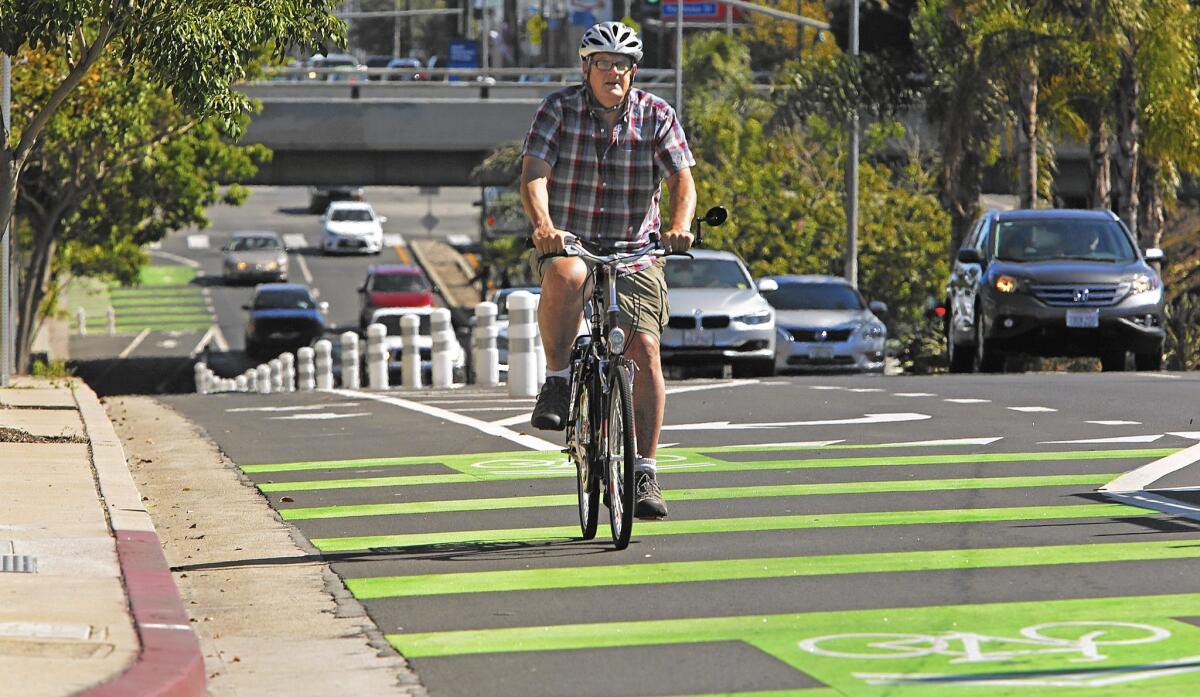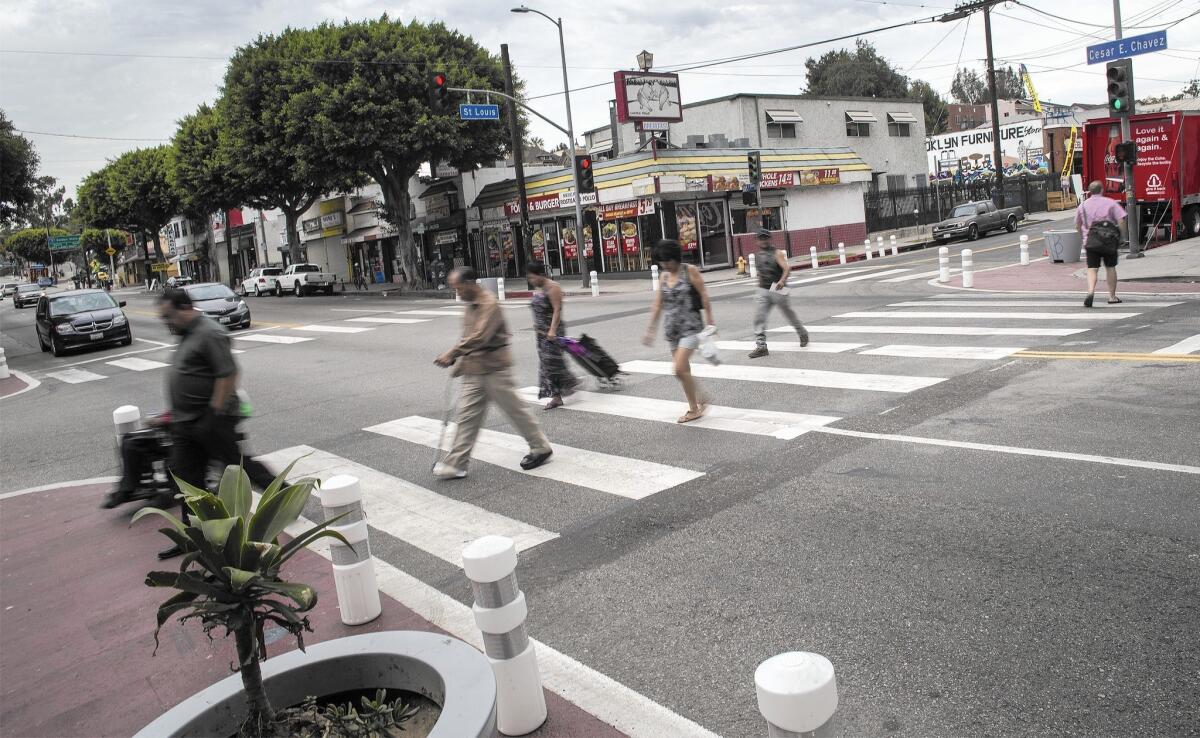First & Spring: City Council sets stage for a do-over on 20-year traffic plan

Just a few months ago, dozens of activists appeared before the Los Angeles City Council to speak out on Mobility Plan 2035, the sweeping proposal for adding hundreds of miles of new bus- and bike-only lanes.
On Tuesday, partisans on both sides will get another chance to sound off — but not because the council wanted another airing of the controversial plan, which seeks to reduce Angelenos’ reliance on the automobile.
Faced with a lawsuit from a Westside nonprofit, several council members have concluded that they need to rescind the plan that was passed in August, make some quick changes and approve a slightly different version of the same document.
Backers of the mobility plan describe the do-over as a minor procedural matter, one that will strengthen the city’s hand in court. Critics see the maneuver as a tacit admission that the city did things wrong the first time around. The mobility plan, foes say, is just the latest example of city planning decisions that don’t hold up under legal scrutiny.
“The City Council seems to operate as, ‘Catch us if you can,’ or ‘Sue if you don’t like it,’” said Laura Lake, a board member with Fix the City, which went to court over the Mobility Plan in September.
Opposition groups have managed, in recent years, to torpedo city decisions on an array of development projects, many of them in Hollywood: a 22-story apartment tower, a Target shopping center and the pair of planned skyscrapers known as the Millennium project. In each case, city leaders have had to go back to the drawing board after lawsuits and legal rulings.
Fix the City, along with two other groups, also succeeded in forcing the council to rescind its new Hollywood Community Plan, which sought to allow bigger development near mass transit stops, and start over with the environmental review. In its latest lawsuit, Fix the City says city officials failed to properly examine the effects on traffic, air quality and public safety of removing car lanes from major boulevards, as is expected under the new mobility plan.
NEWSLETTER: Get the day’s top headlines from Times Editor Davan Maharaj >>
In its same lawsuit, the advocacy group also lodged a more obscure procedural challenge, saying the council altered the plan at the last minute in a way that ran afoul of the City Charter, which governs city decision-making.
Since the lawsuit was filed, critics of the mobility plan have tried to get the word out on the revote, set for Tuesday at the council’s Planning and Land Use Management Committee. Backers of the plan have shrugged off those efforts, saying one more public meeting won’t change a thing.

Opponents “can say whatever they want. The council is on the record” in favor of the mobility plan, said Eric Bruins, planning and policy director for the Los Angeles County Bicycle Coalition.
Supporters say the mobility plan’s list of projects and policies will meet a growing public demand for more transportation options, particularly bike lanes and public transit. Those projects will make city streets less dangerous, in part by lowering traffic speeds and separating bikers and walkers from cars, advocates say.
Foes, on the other hand, have voiced alarm at the prospect of adding bicycle lanes on corridors such as Westwood and Van Nuys boulevards. They point to a city environmental impact report, which said the package of road redesigns would increase congestion and harm police and firefighter response times.
Council President Herb Wesson, who presided over the mobility plan vote declined to discuss the do-over, saying the issue is the subject of litigation. Rob Wilcox, spokesman for City Atty. Mike Feuer, said the council is working to address “procedural issues” and would not comment further.
But Councilman Gil Cedillo, who represents neighborhoods stretching from Westlake to Highland Park, said he and his colleagues were “ill advised” by the city’s legal team when they cast their votes. Cedillo, who cast one of the two votes against the mobility plan, repeated his argument that the list of proposed road projects would make life worse for commuters.
“A recent poll in the L.A. Times found that traffic is the No. 1 concern of the people, the residents of the city of Los Angeles — not public safety, not the high cost of living, not cleanliness of the city. Traffic,” he said. “Yet we voted hastily for a plan that increases traffic.”
Councilman Felipe Fuentes, who represents part of the San Fernando Valley, offered a more optimistic view of the upcoming vote, saying it would give his colleagues another chance to talk about alternatives to driving. He defended the city attorney’s work and reaffirmed his support for the mobility plan.
“We didn’t do [the vote] properly. That’s life in the big city,” he said. “I’d rather fix things than have to be [ordered by a judge] in court to fix them.”
At issue are three changes backed by the council in the run-up to its Aug. 11 mobility plan vote. Councilman Jose Huizar’s planning committee added an amendment to ensure that the council, and not just the mayor’s office, would be in charge of carrying out the plan, according to Fix the City’s lawsuit. It also added language saying “equity” should be a factor when deciding which transportation project is approved. Meanwhile, Councilman David Ryu won passage of a third amendment that said that public safety should be evaluated before approving changes to public streets.
Those changes, according to lawyers with Fix the City, should have been vetted by the Planning Commission, as required by the City Charter. That extra step is needed when the council acts to amend its general plan, as lawmakers did in August.
The council is set to rescind the mobility plan and replace it with an older version, one that does not have the various changes. But Lake contends that officials are doing that wrong too.
The very act of rescinding the document, even for a moment, also must be sent to Mayor Eric Garcetti’s planning commissioners for review, she said. Put another way, Fix the City is arguing that the council’s effort to correct its procedural problems is itself vulnerable to a legal challenge.
“They don’t have the patience or the time to do it right,” Lake said. “So they’re doing it wrong again.”
Feuer’s spokesman did not respond to those assertions. And other council members made it clear they expect to approve the mobility plan one more time.
“Nothing has changed in our commitment to multi-modal transportation in Los Angeles,” Councilman Mike Bonin said in an email. “And we will adopt the exact same Mobility Plan that was approved by the Planning Commission as soon as possible.”
Twitter:@DavidZahniser
ALSO
Early morning shootings leave 1 dead, 2 wounded in Lennox
Secret military exercises change approach for some LAX flights
L.A. Board of Education will weigh Broad charter-expansion plan
More to Read
Sign up for Essential California
The most important California stories and recommendations in your inbox every morning.
You may occasionally receive promotional content from the Los Angeles Times.











